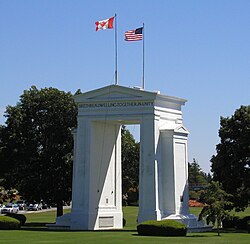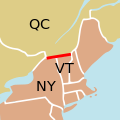Canada–United States border
The border of the Canada and United States, called the Canada–United States border or officially known as the International Boundary, is the longest international border in the world shared between the same pair of countries. The terrestrial boundary (including small portions of maritime boundaries on the Atlantic, Pacific, and Arctic coasts, as well as the Great Lakes) is 8,891 kilometres (5,525 mi) long, including 2,475 kilometres (1,538 mi) shared with Alaska. It is Canada's only land border.
| Canada–United States border | |
|---|---|
 | |
| Characteristics | |
| Entities | |
| Length | 8,891 km (5,525 mi) |
| History | |
| Established | September 3, 1783 Signing of the Treaty of Paris at the end of the U.S War of Independence |
| Current shape | April 11, 1908 Treaty of 1908 |
| Treaties | |
| Notes | See list of current disputes |

Canada–United States Border Media
US and Canadian border security working together at Vancouver International Airport
The 45th parallel (marked in red) was established as a border between the Province of Quebec and the United States in the Treaty of Paris, following the line of a 1763 declaration by King George III.
Signing of the Treaty of Ghent in 1814, which ended the War of 1812 and returned the border to its pre-war state. Subsequent treaties agreed upon saw the border demilitarized, and most boundary disputes resolved.
Disputed territory between British North America and Maine marked in pink. The dispute was settled in the Webster–Ashburton Treaty in 1842. The green line on the map marks the final border.
Map of the disputed Oregon Country, with the American and British claims marked. The dispute was settled in the Oregon Treaty, placing the boundary along the 49th parallel, excluding Vancouver Island.
The Poker Creek–Little Gold Creek Border Crossing at the Alaska–Yukon border closed as a result of the COVID-19 pandemic.
U.S. counties (or county equivalents) sharing a land or water border with Canada Land border Water border only









